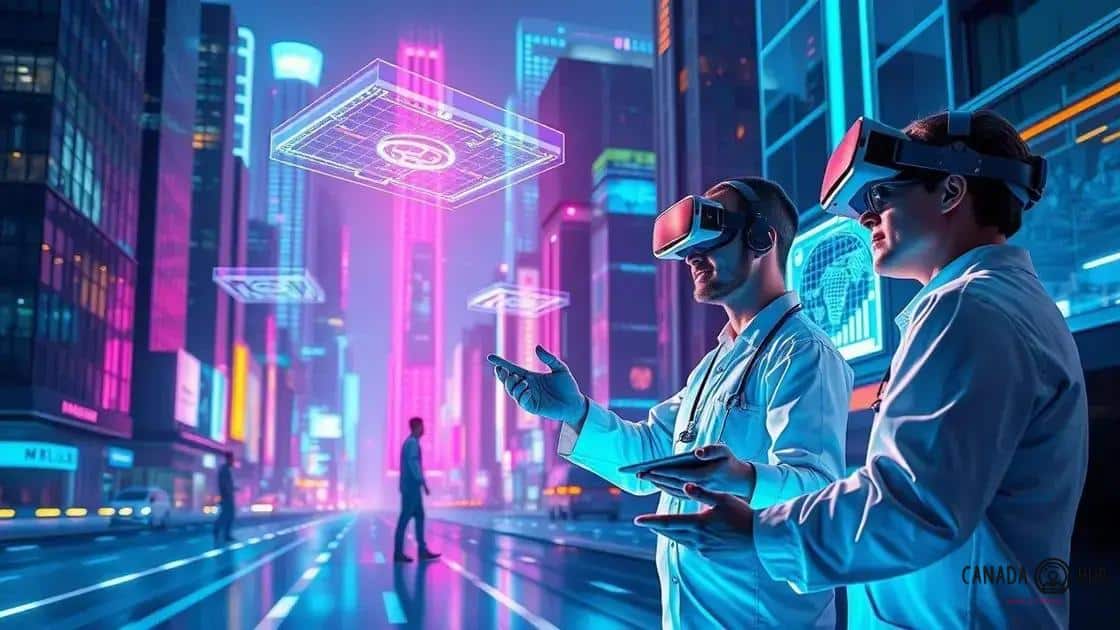Increased investment in spatial computing technologies for industries

Increased investment in spatial computing technologies enhances customer engagement, operational efficiency, and decision-making while also presenting challenges such as high costs and the need for specialized skills.
Increased investment in spatial computing technologies is driving innovation across various sectors. You might wonder how these advancements can directly impact your industry, right? Let’s dive into the details and explore the fascinating world of spatial computing.
What is spatial computing technology?
Spatial computing technology represents a blend of physical and digital worlds. It allows us to interact with digital information in three-dimensional spaces, transforming how we engage with technology.
One of the key aspects of spatial computing is its ability to create immersive experiences. These experiences can be applied across various sectors, enhancing user interaction and engagement.
How does it work?
Spatial computing utilizes a range of technologies such as augmented reality (AR), virtual reality (VR), and the Internet of Things (IoT). By merging these elements, users can perceive and interact with digital objects as if they were real.
- Augmented reality overlays digital information onto the physical world.
- Virtual reality immerses users in completely digital environments.
- The Internet of Things connects everyday objects to the internet, enhancing data collection and interaction.
The applications of spatial computing are vast. For example, in healthcare, doctors use AR to visualize anatomy during surgery. In education, students can explore complex subjects through immersive VR environments. This tech not only enhances learning but also fosters creativity and innovation.
As industries continue to invest in these technologies, we can expect to see even more exciting advancements in the near future. Imagine walking through a store while your device highlights special offers and product information right in front of you. The potential for spatial computing is immense and can reshape our daily experiences.
Benefits of investing in spatial computing

Investing in spatial computing brings numerous benefits that can significantly enhance various industries. With advancements in technology, businesses are discovering how this innovation can transform their operations and customer interactions.
One major advantage is improved decision-making. By utilizing data visualizations and immersive simulations, organizations can analyze complex data more effectively. This helps in making informed choices based on real-time insights.
Enhanced Customer Engagement
Another key benefit is the ability to create engaging experiences for customers. Spatial computing allows businesses to showcase products in innovative ways, making the shopping experience more interactive.
- Augmented reality can let customers visualize how a product fits into their space.
- Virtual reality can provide immersive previews of services or experiences.
- These experiences can increase customer satisfaction and loyalty.
Moreover, investing in spatial computing can lead to increased efficiency. Companies can streamline their processes through automation, allowing staff to focus on higher-value tasks. This can lead to cost savings and higher productivity.
On top of that, spatial computing opens doors for innovation. By leveraging these technologies, businesses can create new products, services, and even revenue streams. This encourages growth and keeps companies competitive in today’s fast-paced market.
Top industries leveraging spatial computing
Various industries are now leveraging spatial computing to transform their operations and enhance customer experiences. This technology is making waves in areas that benefit from immersive and interactive data visualization.
The healthcare industry stands out as a major player. Doctors are using augmented reality for surgical planning and training. This technology allows for 3D views of anatomy, helping surgeons make more informed decisions.
Retail Sector Innovations
In the retail sector, companies are utilizing spatial computing to create engaging shopping experiences. Virtual fitting rooms can change the way customers try on clothes, while augmented reality apps help shoppers visualize furniture in their homes.
- Increased customer engagement and satisfaction.
- Better product visualization and interaction.
- Enhanced marketing strategies and campaigns.
Moreover, the manufacturing industry is harnessing spatial computing for design and production processes. By using virtual simulations, manufacturers can test products in a controlled environment before moving to production. This leads to cost savings and improved product quality.
The architecture and construction industries are also benefiting from these technologies. Designers can create 3D models that stakeholders can explore, leading to better collaboration and fewer misunderstandings. This not only streamlines the design process but also reduces errors.
Future trends in spatial computing investment

As technology evolves, the future of spatial computing investment looks promising. Businesses are starting to understand the long-term benefits of integrating these technologies into their operations.
One major trend involves the increasing use of artificial intelligence (AI) within spatial computing. AI can help analyze data, making interactions more personalized and efficient. This combination of technologies will likely result in smarter applications that adapt to user needs.
Expansion of Augmented and Virtual Reality
The adoption of augmented reality (AR) and virtual reality (VR) is also expected to grow. More industries will use these technologies to enhance experiences. For example, training programs in healthcare and manufacturing will become more immersive, allowing workers to practice skills in realistic environments.
- Increased accessibility of AR devices and software.
- Collaborative tools for remote teams using VR.
- Development of user-friendly applications for consumers.
Additionally, investments in spatial computing are likely to focus on improving interoperability across platforms. This means creating systems that work together seamlessly, improving user experience. For example, allows users to interact with various devices, apps, and environments more easily.
Another exciting trend is the convergence of spatial computing with 5G technology. With faster speeds and lower latency, the ability to stream large amounts of data in real-time opens up new possibilities. This will lead to more dynamic and interactive experiences for users, boosting engagement in multiple sectors.
As the market continues to grow, we can expect to see increased competition among technological companies, pushing forward innovation and development. Overall, the future appears bright for spatial computing investments as more industries recognize their potential.
Challenges in adopting spatial computing technologies
Adopting spatial computing technologies presents several challenges for businesses, even as these innovations promise significant advantages. Understanding these obstacles is crucial for successful implementation.
One major challenge is the high cost of initial investment. Businesses must invest in advanced hardware and software, which can be a barrier for smaller companies. These expenses include purchasing devices, developing applications, and ensuring proper integration into existing systems.
Technical Expertise
Another hurdle involves the need for specialized technical expertise. Often, companies lack the skilled workforce to develop and implement these technologies. Finding experts in augmented reality (AR) and virtual reality (VR) can be difficult, leading to delays in adoption.
- Training staff to use new systems effectively.
- Hiring skilled professionals familiar with spatial computing.
- Creating a culture open to technological changes.
Data security and privacy concerns also play a significant role in the adoption process. Businesses must ensure that sensitive information is protected when using these technologies. Failure to address these concerns can lead to breaches, which can damage a company’s reputation and cost valuable resources.
Moreover, integrating spatial computing into existing workflows can be complex. Companies often face compatibility issues with current systems, leading to operational disruptions. It’s essential to have a well-planned strategy to guide the transition.
FAQ – Frequently Asked Questions about Spatial Computing Investment
What is spatial computing?
Spatial computing combines physical and digital worlds, allowing users to interact with digital information in three-dimensional environments.
What are the main benefits of investing in spatial computing?
Investing in spatial computing can enhance customer engagement, improve decision-making, and increase operational efficiency across various industries.
What challenges do companies face when adopting spatial computing technologies?
Companies often encounter high initial costs, a need for skilled professionals, data security concerns, and integration issues with existing systems.
How will spatial computing evolve in the future?
In the future, spatial computing is expected to integrate more with AI, expand the use of AR and VR, and improve interoperability across platforms, leading to more dynamic user experiences.





